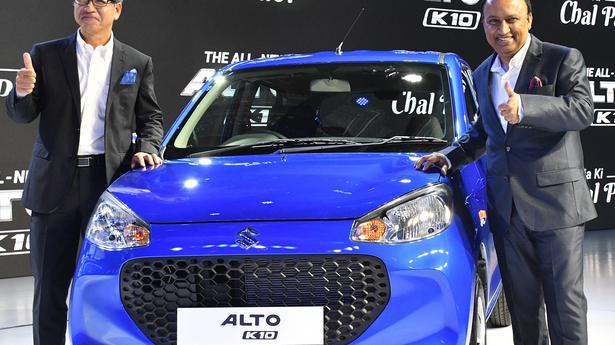
Maruti needs to keep small car segment energised with new products: MD&CEO Takeuchi
The Hindu
‘Company will continue to focus on all segments’
A large section of customers still prefer hatchbacks despite sales growth of SUVs and Maruti Suzuki India feels the need to keep the small car segment 'energised' with new products, company MD & CEO Hisashi Takeuchi said on Thursday.
The company, which on Thursday launched the all-new version of its small car Alto K10 with a price range of ₹3.99- 5.83 lakh (ex-showroom), will continue to focus on all segments, including the entry-segment, even as it brings more technology and feature-packed products.
"India is a vast country with a diverse demography. Just like cuisine and culture, customer requirements and preferences also change from place to place... While SUVs have definitely gained popularity in recent times, a large section of customers still prefer hatchbacks," Mr. Takeuchi said.
He further said in last fiscal year, the Indian passenger vehicle industry sold over 11.5 lakh hatchbacks. "Out of that we have over 68% market share. As a market leader, we need to keep the hatchback segment energised with exciting products," he added.
In 2021-22, total domestic passenger vehicle sales were at 30,69,499 units, according to the Society of Indian Automobile Manufacturers (SIAM). On the significance of the brand Alto, he said it was the number one selling car for 16 consecutive years till 2020.
Even in last fiscal year, he said Alto was the fourth best-selling model. The Alto model was first launched in September 2000. By July 2022, Alto had sold over 43.3 lakh units in total in India, Takeuchi said.
The all-new Alto K10 is powered by the company's next-generation K-Series 1-litre petrol engine and delivers fuel efficiency of up to 24.9 kilometer per litre, he claimed.

The Union Budget unveiled on February 1, 2025, has come at a time of unprecedented global uncertainty and a flagging domestic economy. The real GDP growth is estimated at 6.4% for 2024-25 and between 6.3-6.8% for 2025-26, a far cry from >8 percent growth required annually to make India a developed nation by 2047. While much attention has been devoted to the demand stimulus through income tax cuts, not enough is said about the proposed reforms in urban development, tariff rationalisation, and regulatory simplification aimed at making Indian cities and corporates more competitive. Since the majority of economic activity is located in cities (urban areas account for ~55% of GDP) and produced by large corporates (~40% of the national output and 55% of India’s exports), the above-mentioned reforms have a pivotal role in improving India’s trend growth rate. Below we unpack each reform.












